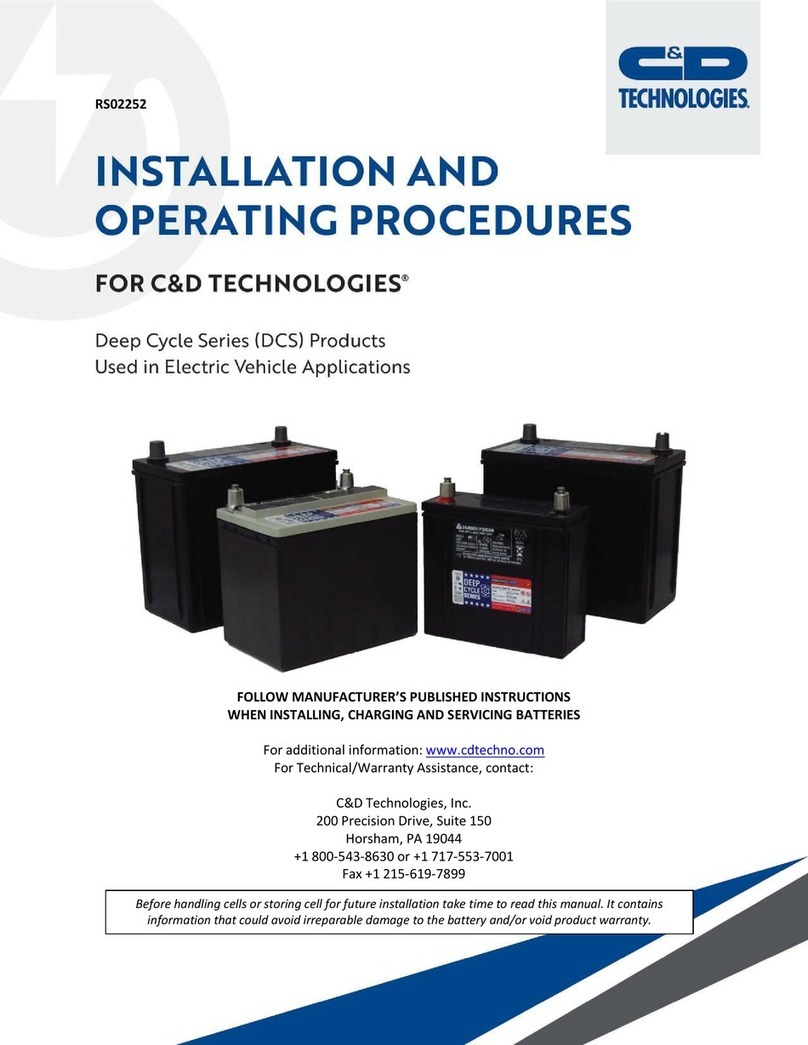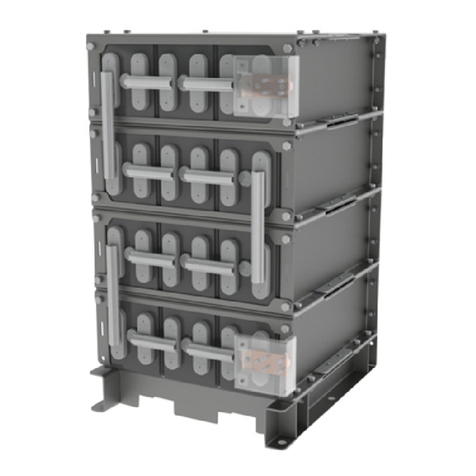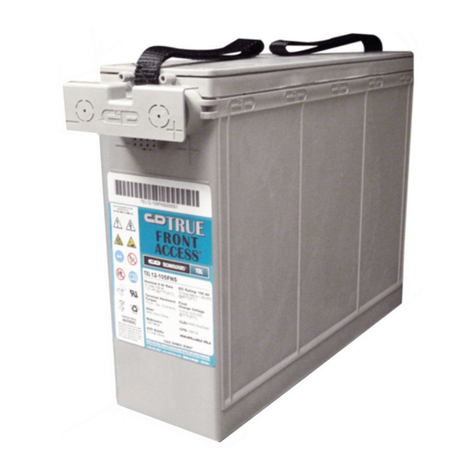
SAFETY PRECAUTIONS
Owners are hereby advised that access to this battery should be limited to personnel who
have been trained in the installation, preparation, charging and maintenance on this specific
battery type and model. WARNING
SHOCK HAZARD - PHYSICAL CONTACT WITH UN-INSULATED BATTERY
CONNECTORS OR TERMINALS SHOULD BE AVOIDED AT ALL TIMES. CARE
SHOULD BE TAKEN TO DISCHARGE STATIC ELECTRICITY FROM ANYTHING
OR ANYONE WHO MAY COME IN CONTACT WITH THE BATTERY BY
MAINTAINING PHYSICAL CONTACT WITH A GROUNDED SURFACE IN THE
VICINITY OF THE BATTERY BUT AWAY FROM THE CELLS AND FLAME
ARRESTERS.
ALL TOOLS SHOULD BE ADEQUATELY INSULATED TO AVOID THE POSSIBILITY
OF SHORTING CONNECTIONS. DO NOT LAY TOOLS ON THE TOP OF THE
BATTERY.
ALTHOUGH C&D TECHNOLOGIES LIBERTY®SERIES 1000 (FAM AND LFA) FRONT
ACCESS MONOBLOCK BATTERIES ARE SEALED AND EMIT NO GAS DURING
NORMAL OPERATION, THEY CONTAIN POTENTIALLY EXPLOSIVE GASES, WHICH
MAY BE RELEASED UNDER ABNORMAL OPERATING CONDITIONS, SUCH AS A
CHARGER MALFUNCTION. THE BATTERY INSTALLATION LOCATION SHOULD BE
A WELL VENTILATED AREA SO AS TO PREVENT HYDROGEN GAS ACCUMULA-
TION IN THE VICINITY OF THE BATTERY FROM EXCEEDING 2% BY VOLUME.
NEVER INSTALL BATTERIES IN A SEALED CABINET OR ENCLOSURE. IF YOU
HAVE ANY QUESTIONS, CONTACT YOUR LOCAL C&D AGENT.
THIS BATTERY CONTAINS SULFURIC ACID, WHICH CAN CAUSE SEVERE
BURNS. IN CASE OF SKIN CONTACT WITH ELECTROLYTE, REMOVE
CONTAMINATED CLOTHING AND FLUSH AFFECTED AREAS THOROUGHLY
WITH WATER. IF EYE CONTACT HAS OCCURRED, FLUSH THE EYE FOR A
MINIMUM OF 15 MINUTES WITH LARGE AMOUNTS OF RUNNING WATER AND
SEEK IMMEDIATE MEDICAL ATTENTION.
WARRANTY NOTICE
This instruction manual is not a warranty. This battery is sold subject to a limited warranty, which is offered in lieu of all other
warranties, express or implied (including the warranties of merchantability or fitness for a particular purpose). A copy of the
applicable limited warranty is available upon written request from C&D TECHNOLOGIES, Inc. 1400 Union Meeting Road PO
Box 3053 Blue Bell, PA 19422-0858 or in Canada C&D TECHNOLOGIES, Inc. 7430 Pacific Circle Mississauga, ON L5T 2A3
Request Warranty Certificate RS-1827.
The data and specifications indicated herein are subject to revision by C&D Technologies, Inc. without notice. While the
information presented herein is believed to be accurate, C&D Technologies, Inc. makes no warranty and hereby dis-
claims all warranties, express or implied, with regard to the accuracy or completeness of the information indicat-
ed herein. Further, because the products featured herein may be used under conditions beyond its control, C&D
TECHNOLOGIES, INC. HEREBY DISCLAIMS ALL WARRANTIES, EITHER EXPRESS OR IMPLIED, INCLUDING THE
WARRANTIES OF MERCHANTABILITY AND FITNESS FOR A PARTICULAR PURPOSE. The user is solely respon-
sible for determining the suitability of C&D Technologies, Inc.’s products for user’s intended purpose and in
user’s specific application.
































